Contents
- Introduction
- Tropical bonsai winter care
- Plant hardiness
- Preparing bonsai for winter storage
- Winter storage strategies
- Spring care: removing trees from winter storage
- Winter routines from around North America
- Links in this article
Introduction
Depending on where you live and what kind of trees you grow, your bonsai may need protection from the elements in winter. To help you figure out which trees need protection and how you can provide it, this article will provide an overview of the kinds of shelter your trees might need and tips from cold-climate growers for ensuring your trees stay healthy through winter.
Cold, of course, is relative. If winters are mild where you live and you don’t expect temperatures to drop below 30 degrees F for more than a few hours over the course of winter, your temperate trees may not need any protection at all.
Temperate species include pines, maples, junipers, and elms, among others. The bulk of coniferous and deciduous species are temperate and can handle varying levels of cold in winter. Many require it and will lose vigor or fail to produce fruit if they don’t spend enough hours below a certain temperature.
This isn’t the case for tropical or sub-tropical bonsai. These trees, including ficus, premna, jade, and serissa, don’t grow as well when it gets cold. Tropical species that grow indoors year round don’t typically require special care in winter, but if you grow tropical bonsai outdoors in summer, these trees will need additional shelter when temperatures start to drop into the 50s (F).
Tropical bonsai winter care
The easiest solution for tropical bonsai is to bring them indoors for the winter months. Place the trees in a bright, warm, spot and continue to water when the soil begins to dry out. Avoid placing the trees near heating vents that can dry out bonsai quickly.
If you have more tropical bonsai than you have space for inside, heated patios, sunrooms, or greenhouses are good options.
Many tropical bonsai will actually be OK outdoors in temperatures down to 35 or 40 degrees, depending on the species, but they are likely to drop leaves and stop growing until the weather warms up. Providing additional heat and shelter for tropical bonsai can keep them looking good year round.
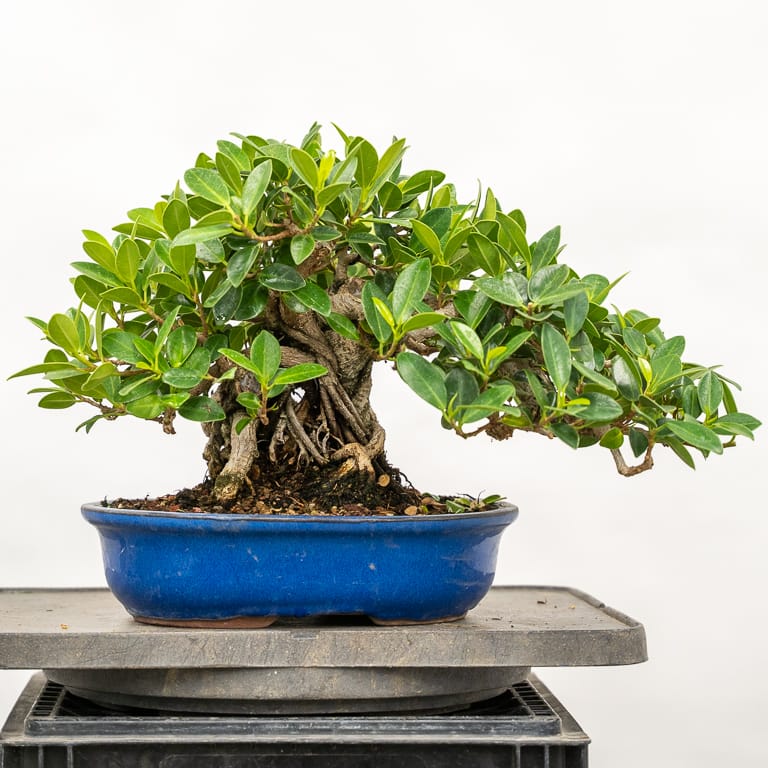
Green Island ficus
Plant hardiness
The cold hardiness of temperate species can vary wildly. The primary tool for determining bonsai cold hardiness is to identify your USDA Plant Hardiness Zone and then look up the zone for the trees you are growing.
While this is a good starting point, there are several caveats that suggest you might want to take a more conservative approach to winter care.
Elevation, precipitation, and season length – particularly the number of freeze-thaw cycles – can also vary widely within zones. For example, Austin, TX and Seattle are both zone 8b, but their climates don’t have much in common beyond similar lows and total precipitation. (As I write this, the weather is 72 degrees F in Austin and 45 degrees F in Seattle.)
A bigger limitation of zone designations is that they apply to plants that are growing in the ground. As bonsai live in containers, the root temperatures can drop far lower than temperatures in the ground making them susceptible to damage at warmer temperatures than their zone designation suggests.
The best resource for identifying safe winter temperatures for your bonsai is a chart in Bonsai Heresy by Michael Hagedorn. In it, you’ll find the root hardiness and the top hardiness of species commonly grown as bonsai.
I also recommend chapters 11, 12, and 13 from Bonsai Heresy as they discuss key aspects of dormancy including light requirements, temperature, and root hardiness with the aim of helping you keep your trees healthy over winter.
Even within a given species, you might find that young prebonsai can withstand lower temperatures than older, more refined trees. If your refined bonsai lose branches over winter but the younger trees do fine, you’ll need to provide more shelter for the refined trees.
Likewise, trees that were recently collected from the mountains, dug from the ground, or lacking healthy roots will all need more shelter in winter than trees with healthy, established rootballs.
As you might expect, larger pots provide more insulation to roots than smaller pots, and sick trees recovering from infestation or fungal pathogens require extra protection, as do recently rooted cuttings.
You might also know about cases of cold hardy species suffering damage from unexpected frosts in fall or spring. This is because cold hardy species aren’t automatically prepared for cold temperatures every day of the year.
Trees respond to day length, temperature, and the difference between daytime and nighttime temperatures as cues that kick-off different aspects of dormancy. Until trees reach full dormancy, they may not be able to withstand the temperatures noted in hardiness charts.
Although most temperate species require protection below 25 degrees F, some species are well known to withstand much cooler temperatures. Especially hardy species commonly trained as bonsai include:
- Larch
- Jack pine
- Eastern white cedar
- Eastern red cedar
- Rocky mountain juniper
- Amur maple
- Red maple
- Native plums
For more information about how trees respond to cold temperatures, see Freeze Damage in Woody Plants by Andy Walsh.
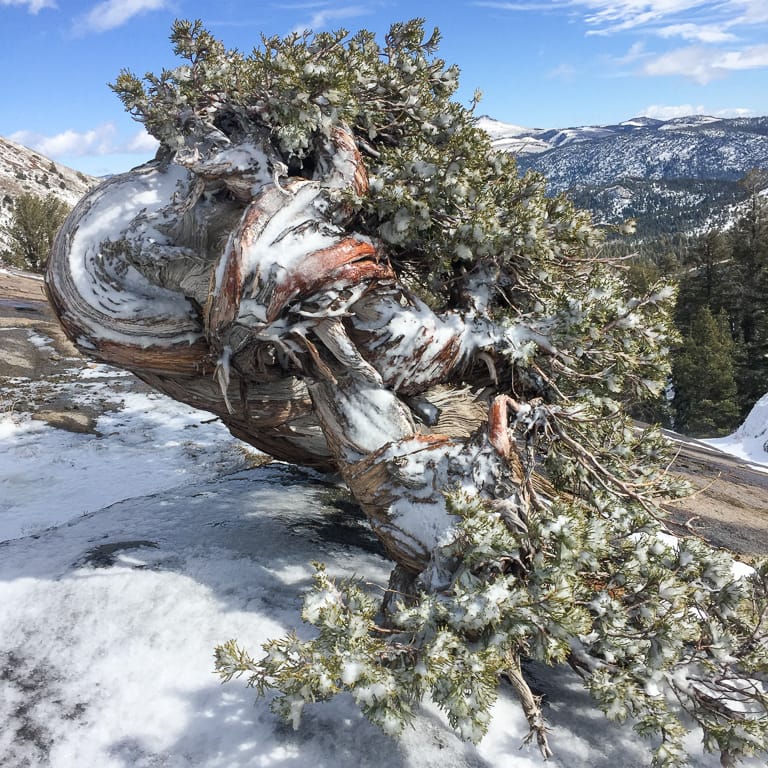
Sierra juniper after first snow
Preparing bonsai for winter storage
Taking a few steps before putting your trees away for winter can have a big effect on how well they’ll grow the following spring.
Begin by removing leaves from deciduous trees and brown needles from conifers. If trees show any signs of insects or fungus in fall, treating them before moving them into storage will help them recover and prevent the problem from spreading to other bonsai. Some people apply dormant oil to all of their trees in fall as a precaution.
The next step is to remove any fertilizer build-up on the surface of the soil. Organic fertilizers like cottonseed meal or homemade fertilizer balls, aka dango, can break down over the growing season and form a crust that makes watering difficult. By removing the crusty surface soil and replacing it with fresh soil, you can make it easier to water trees over winter. See “Summer soji” for details about how to do this.
Finally, the most important step before overwintering bonsai is to let the trees experience some cold weather.
Without experiencing cold weather, many trees don’t fully enter dormancy. Depending on where your live and how you plan to store your trees, this might mean waiting for one good frost before tucking your trees in for winter. In colder climates, it can mean waiting for consistent highs in the 30s (F) and lows in the 20s (F).
Once your trees have been treated for insects and fungus, the soil readily accepts water, and a good frost or two has passed, your trees are ready for winter storage.
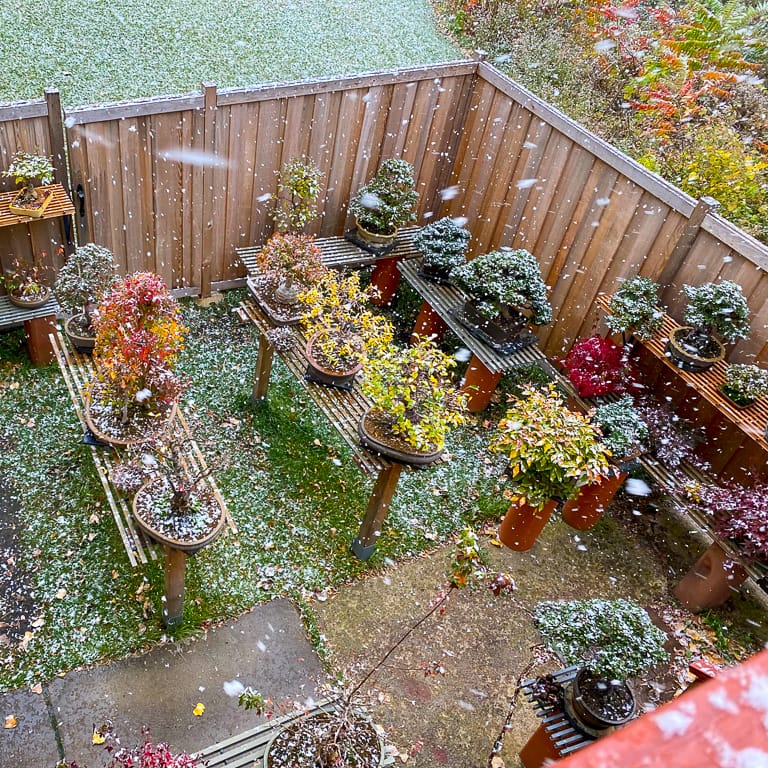
Early snowfall (photo courtesy Jeff in Minnesota)
Winter storage strategies
Identifying suitable winter storage options for your bonsai starts with an understanding of the local weather. Knowing what kind of weather to expect can help you determine how much shelter your trees will need.
Your best resource for this will be local enthusiasts who have experience overwintering bonsai in your area. Checking with your local bonsai club – or the nearest club with similar weather – can be a great starting point for determining what kind of shelter will work for your collection.
Before looking at effective storage strategies, here are some goals to keep in mind.
- Avoid wind. Wind is the most dangerous element in winter as cold air can dry out trees quickly. Trees that dry out in winter are more likely to lose branches or die than trees that are sheltered from the wind.
- Keep trees well-watered. Dormant trees don’t completely shut down in winter. As such, they will continue to need water. Trees in warmer and brighter spots may need watering up to once a week; in cooler spots, watering once a month might be appropriate.
- Reduce temperature fluctuations. For most temperate species, the goal is to maintain temperatures between 33 and 40 degrees F throughout winter. This is cold enough to meet dormancy requirements without exposing trees to harmful temperatures.
- Reduce freeze-thaw cycles. Trees that freeze and thaw frequently experience more stress than trees that consistently stay just above or just below freezing.
- Maintain dormancy for as long as possible. As we’ll cover below, spring care can be challenging in cold climates as late freezes can damage new growth. By keeping trees dormant until freezes become infrequent, you can help your trees grow successfully in spring.
With these criteria in mind, here are some notes about popular approaches to winter storage for bonsai.
- Place trees under benches. If your winters are relatively mild but temperatures can drop into the 20s (F), placing trees on the ground or under benches can provide additional warmth and shelter trees from heavy snow loads.
- Bury trees in the garden. By digging holes big enough for bonsai pots and back filling them with dirt just over the lip of the pot, you can provide insulation for the roots while exposing the tops of trees to the elements. Shoveling snow around the trees up to the first branches can provide additional insulation.
- Place trees in covered or uncovered mulch beds. As an alternative to burying the pots in soil, you can create mulch beds and pack the spaces between pots with bark, mulch, leaves, or straw up to the first branch. For extra protection, place trees next a fence or wall and cover with plastic sheeting.
- Store trees in unheated garages, sheds, or enclosed porches or patios. Storing trees on tables, shelves, or directly on the floor can work, as can building insulated spaces within the garage. Space heaters plugged into a standalone thermostat can provide additional heat.
- Store trees in cold frames. Freestanding cold frames are essentially greenhouses that are kept cool. Simple cold frames can be built with wood and plastic sheeting. Lining greenhouses with foam insulation can provide additional protection. See Winters in Canada by Derek Delisi for how-to instructions for building a cold frame.
- Store trees in heated greenhouses. If your trees require storage within a narrow temperature range, heated greenhouses offer great flexibility. Warm greenhouses kept at 70 degrees F can be used for tropical species while greenhouses between 33 and 40 degrees F are perfect for temperate species that don’t like to freeze. Temperature controlled exhaust vents can help maintain cool temps when the sun is out.
- Store trees in climate controlled basements. If your basement gets cold enough, you can lay down plastic sheeting and store your trees indoors.
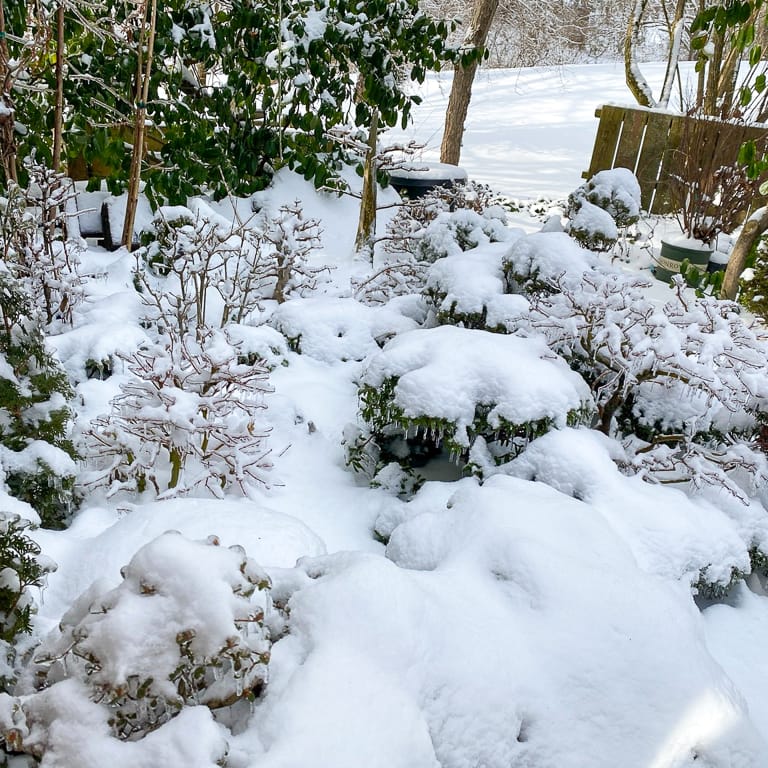
Bonsai under a layer of insulative snow (photo courtesy Joe in Kentucky)
The following tips can help you avoid common pitfalls of winter bonsai storage.
- For trees stored indoors, using fans to circulate the air can cut down on fungus problems.
- For trees stored outdoors, find a location next to a fence or wall to cut down on wind. Shady locations are best for keeping trees cool.
- In areas that receive excessive rain (the Pacific Northwest and the United Kingdom come to mind), trees may need protection to prevent root rot or general weakness in spring. Give these trees a break from the rain by placing them under an eve, keeping them in a greenhouse or cold frame, or placing a plastic sheet over the soil (and checking regularly to make sure the tree gets water when it needs it). Using soil mixes that retain less water can help when excessive moisture is a problem year round.
- Greenhouses and cold frames can heat up rapidly when the sun is out. When possible, set up greenhouses in a shady spot to reduce overheating. Strategies for keeping temperatures cool inside range from covering structures with shade cloth (mounted inside if large snow loads are expected), installing vents, lining the walls, floor, and ceiling with solid insulation, or using buckets of water as heat sinks.
- Heat pads or heat coils can help maintain root temperatures indoors, but note that trees kept on heat pads may require more frequent watering.
- Many species will benefit from light in winter. LEDs on timers are a popular choice for trees stored indoors as they produce little heat.
- Rats, mice, voles, deer, gophers, and rabbits have been known to munch on bonsai over winter. Wire screen can keep critters away from trees in the garden, and bait or traps (that aren’t accessible to pets) can be effective indoors.
- When using heaters to regulate temperatures indoors, consider standalone thermostats as they can offer greater flexibility and reliability than thermostats built into heaters.
- All but the toughest bonsai pots are susceptible to breaking over the course of a cold winter. To ensure your pots remain intact over winter, place trees planted in precious pots in climate-controlled spaces that are kept no colder than 33-40 degrees F.
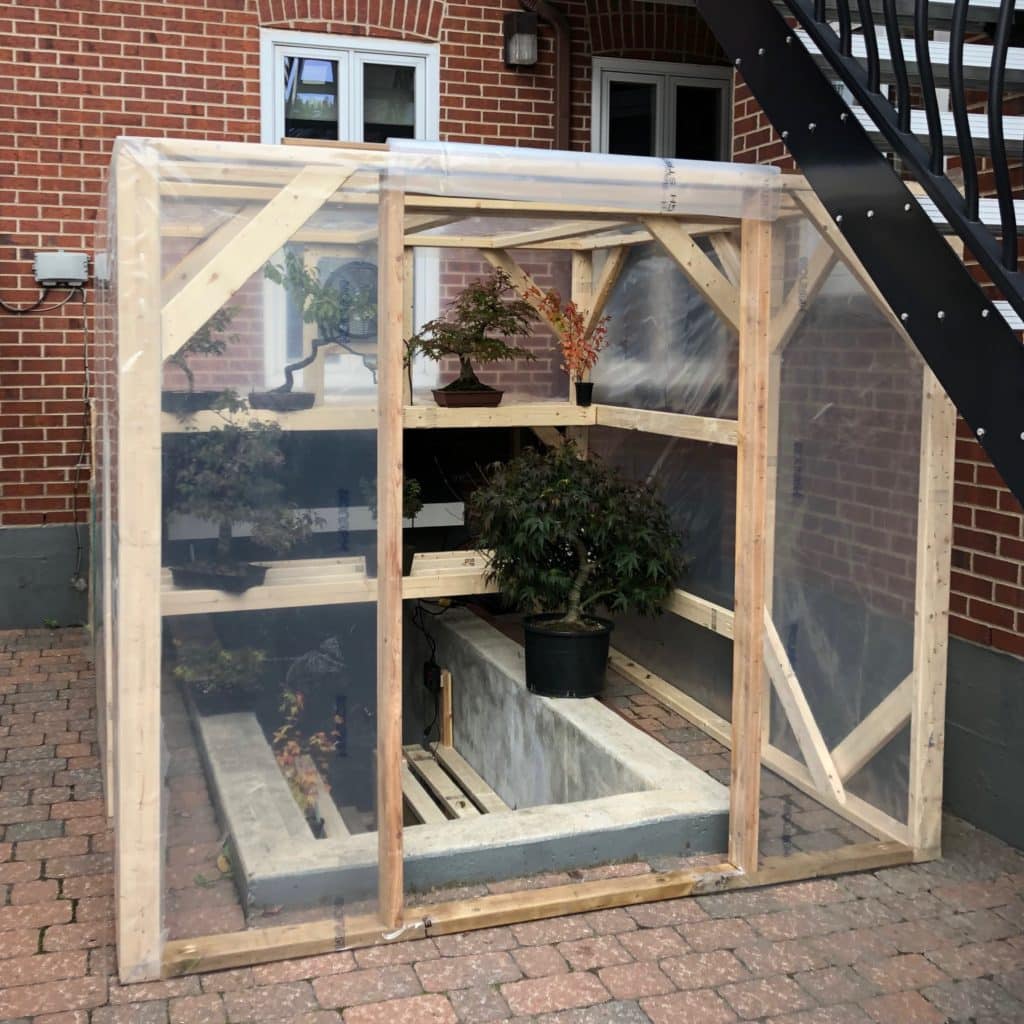
Standalone cold frame (photo courtesy Derek in Nova Scotia)
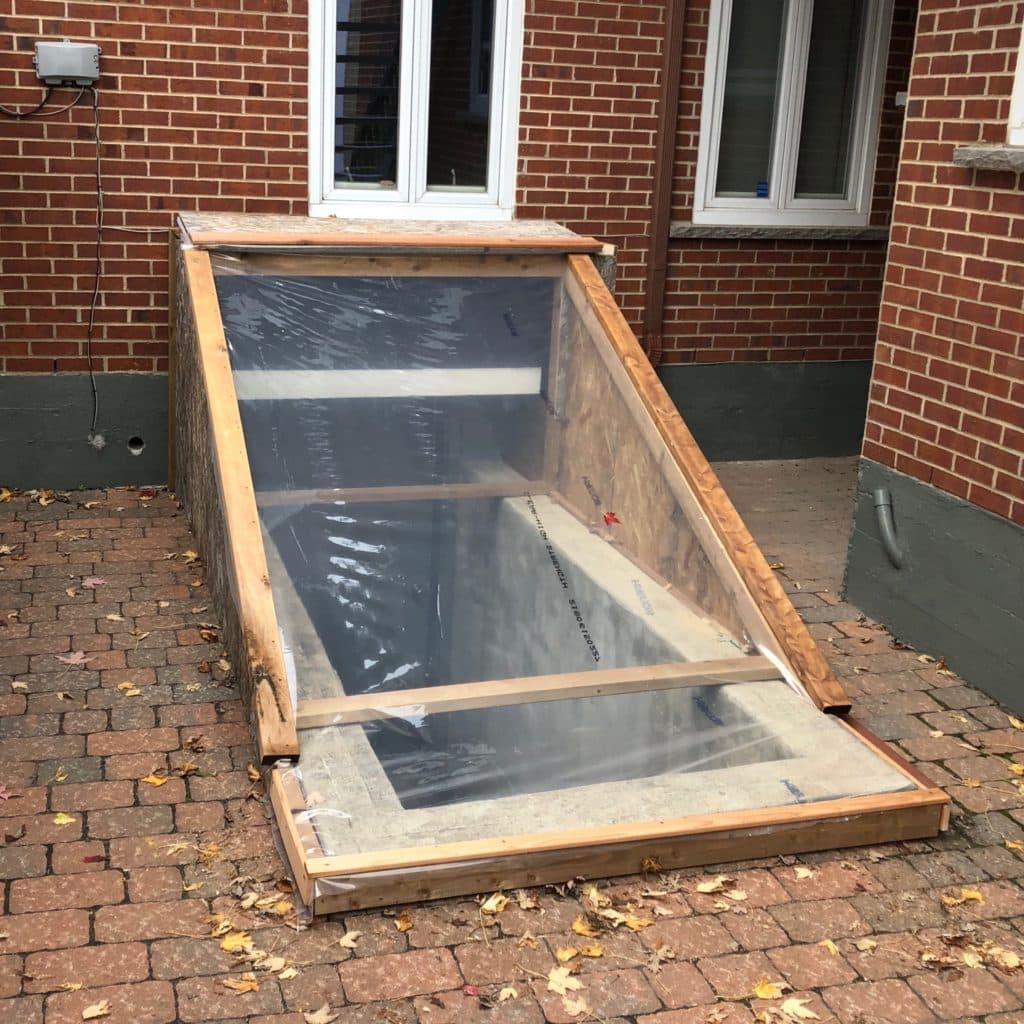
Attached cold frame (photo courtesy Derek in Nova Scotia)
Spring care: removing trees from winter storage
As the days lengthen and temperatures warm up, trees in cold storage areas will begin to grow. When this happens, it’s best to move them into the sun to prevent new growth from becoming weak or leggy.
If, however, nighttime temperatures drop below freezing or a storm passes through, these trees need to go back indoors to protect tender foliage. As moving trees in and out every day can require a lot of effort for people with large collections, many try to keep trees dormant for as long as possible.
An alternative approach is to set up an intermediate greenhouse with warmer temperatures that encourage trees to break dormancy early. This effectively extends the growing season and allows more time for spring repotting.
Trees that leaf out in darkness may experience sunburn when they’re brought out into the sun. Tender foliage is also susceptible to windburn and damage caused by early heat spells. If you see burned foliage, moving trees under shade cloth or to a shady area of the garden can prevent further damage.
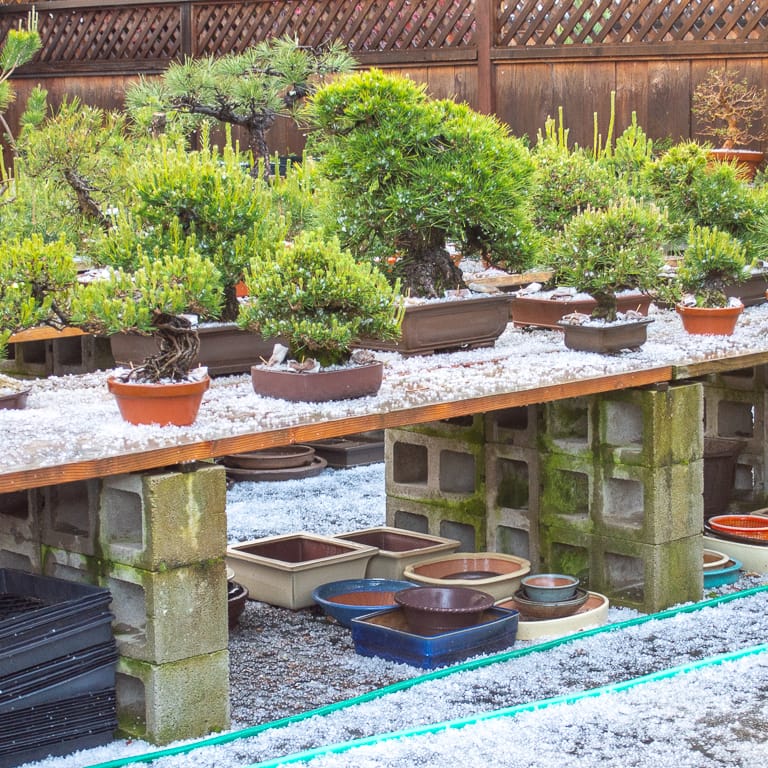
Late spring hail storm – Alameda, California
Winter routines from around North America
Sink bonsai into the ground up to the pot rim; make a wire fence collar around each pot to protect against rodents; pack with leaves that won’t become soggy when wet; let snow cover the leaf piles. (Southern Michigan)
Wrap pots in old nylon stockings to keep the bonsai soil intact and bury the pots in a protected spot; I have followed this for years for most deciduous and conifers without an issue. (Toronto, Ontario)
Keep tropicals in a heated sunroom with constant airflow; keep cold-hardy species outdoors protected from wind and temperature extremes; keep precious and sensitive plants in an unheated garage or greenhouse. (East Hartford, Connecticut)
Shield trees from horizontal winds and mulch below and above the pots; garden benches with removable tops can work great for sheltering small trees. (Southwestern Ontario)
Trim trees and spray dormant oil; scrape off the top layer of fertilizer; apply a layer of straw along a fence or wall; sprinkle snail or bug bait; nestle trees into the straw and tuck straw between trees, lightly covering the roots; cover with plastic sheet secured to a board along the fence. (Washington state)
Place trees in an unheated (but attached to the house) garage with temperatures between 0C to +5C for up to five months; there is no light inside but the conifers come out looking good in spring. (Zone 5, Canada)
Give trees a good drink of water, apply a fungicide, put them about in fish totes (large plastic boxes) in the barge of my houseboat; the salt water rarely goes much below 28 at the surface and generally ranges from 35-45 degrees F all winter. (Fairhaven, Massachusetts)
Spread mulch over the ground, cover with landscape fabric, group trees together, and cover with leaves up to the first branch. (Lexington, Kentucky)
Store trees in an insulated cold frame with heater and fan kept just above freezing; hardy species like larch, jack pine, and red maple stay outside away from the wind: when there is snow, I cover the pots up to the first branch. (Quebec City, Quebec)
Once night temps begin to stabilize outdoors in the high 20’s to low 30’s in spring, move high mountain pines like Ponderosa, Mugo, and Limber back out on the benches. (Milwaukee, Wisconsin)

Insulated cold frame (photo courtesy Jean-Dominic in Quebec)
Links in this article
- USDA Plant Hardiness Map
- Bonsai Heresy by Michael Hagedorn
- Winters in Canada by Derek Delisi
- Freeze Damage in Woody Plants by Andy Walsh
- Winter Care articles and slideshow by members of the Minnesota Bonsai Society
Subscribe to Bonsai Tonight
New Posts Delivered Every Tuesday and Friday